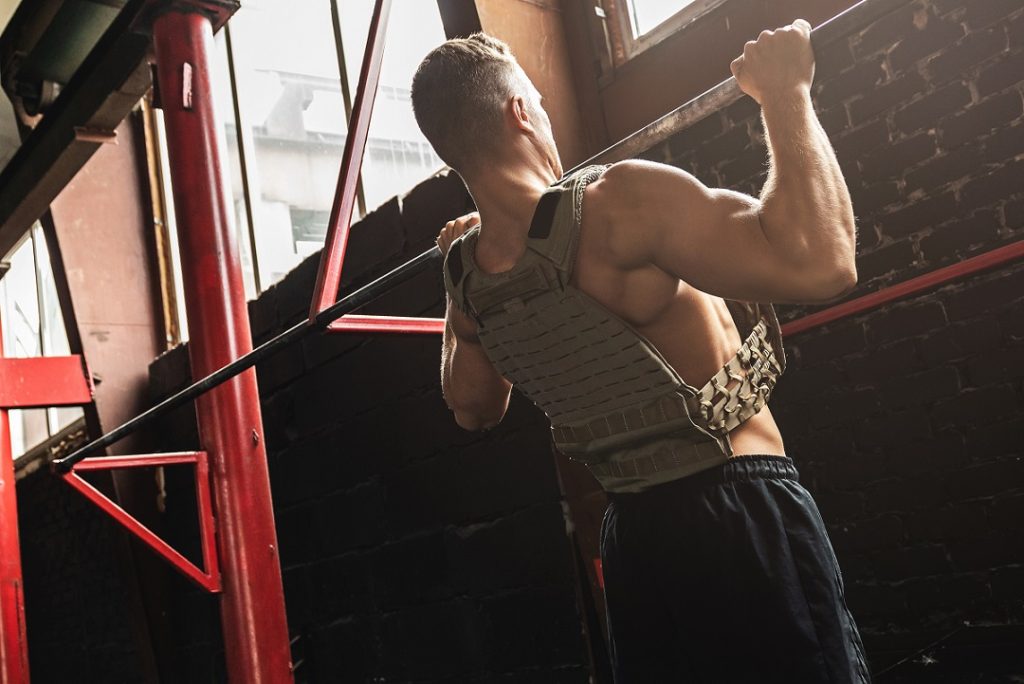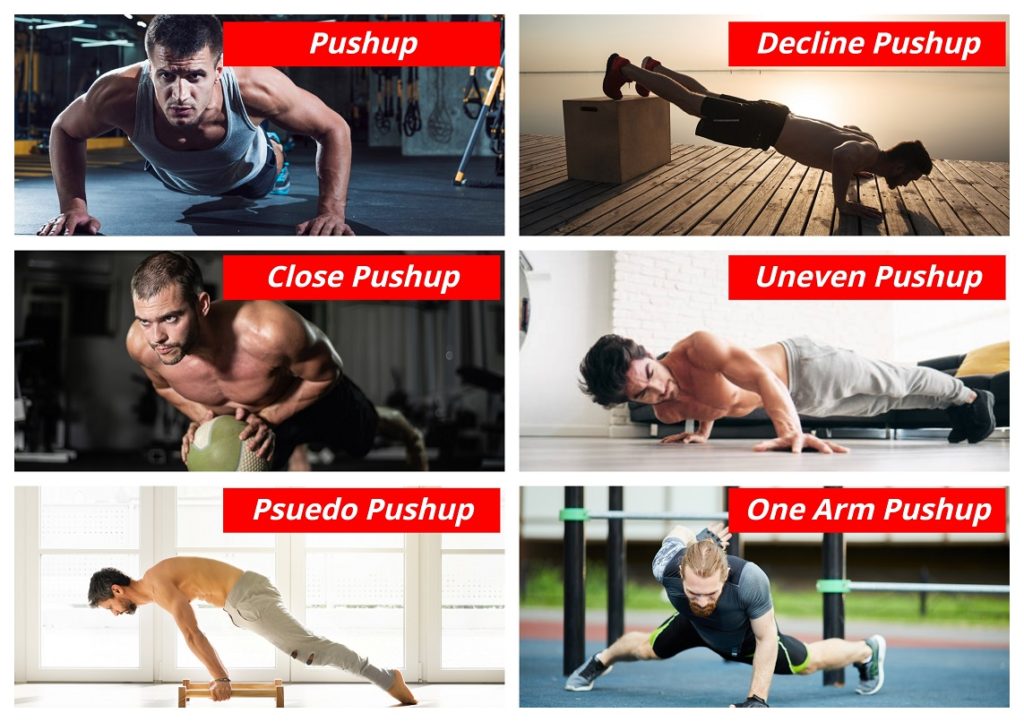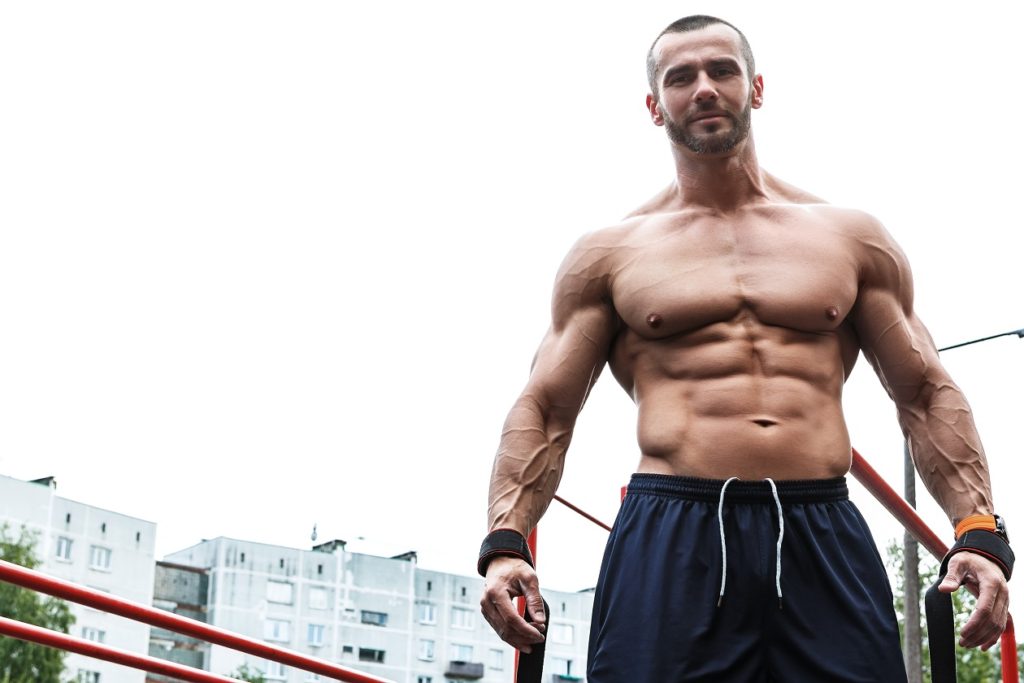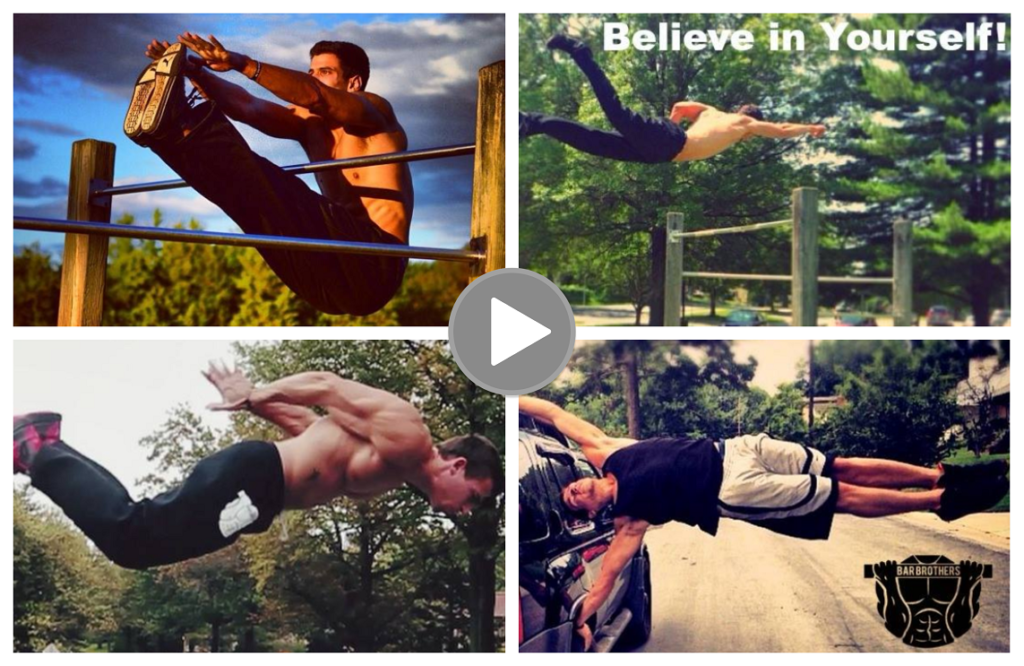Disclosure: This post contains affiliate links. Meaning if you click on a link and make a purchase, I'll earn a small commission at no extra cost to you.
If you’re looking for an intermediate calisthenics workout that gets results. Then this is (without a doubt) the most important page you’re even going to read…
But before we get started, let’s just define the term intermediate.
Now for me, I’ve always seen intermediate workouts as a kind of stepping stone to being able to perform advanced calisthenics skills like the planche, muscle-up, front lever, among many others.
And the truth is that unless you’ve been practicing calisthenics consistently for years, then it’s more than likely that you won’t have anywhere near the strength to pull these moves off successfully.
This is where intermediate workouts reign supreme because, without them. It’s almost impossible to bridge the gap between a beginner and the elite calisthenics athlete.
Take the pushup, for instance…
Now, despite what you might believe, simply doing more pushups isn’t the best way to progress towards performing a one-arm pushup.
You need to build strength. The type of strength that goes way beyond hammering out endless pushups until you pass a kidney stone.
So in today’s blog post, I’m going to dive deep into my training library to deliver a few of my best go-to calisthenics workouts.
I won’t lie. They’ll be blood, sweat, and it might get a little emotional.
But everything I’m about to reveal should be more than enough to keep your workouts interesting over the coming weeks and months.
And by the time your done reading, you’ll be equipped with everything you need to take your calisthenics game to an entirely new level.
Let’s rock and roll…
WATCH VIDEO: Discover How To Build Huge Slabs Of Muscle, Extreme Power, And The Ripped Body Of A Spartan Warrior Using Nothing More Than A Bar And Your Own Bodyweight…
(Video Will Open In A New Window)
Table of Contents
Basic Movement Patterns
Now, before we talk about workout and progressions, I just want to briefly touch on how to utilize specific movement patterns to get the most bang for your buck.
See, unlike bodybuilding, where you’ll hammer your body with both compound and isolation exercise.
Most calisthenics movements tend to me compound based which, if you ask me, is a huge plus when it comes to getting the most out of your training.
So these are what I like to call the six main movement patterns…
- Vertical Pull (pullups/chinups)
- Vertical Push (parallel bar dips)
- Horizontal Pull (inverted row)
- Horizontal Push (pushups)
- Squat (air squats, split squats, etc…)
- A Hinge Movement (hip thrusts)
Now, the reason I like to include all of these movement patterns in my workouts is that they provide the most benefits for your time.
Not only does this help you build a full looking, powerful physique. But because these exercises are compound. There’s also a lot of room for progression once you start to move past the basics.
In the end, this is what’s going to help you get stronger and progress faster than you would otherwise.
Intermediate Workout Progressions
So we’ve already established that to progress beyond the basics, you need to utilize specific compound exercises and lots of them.
But to progress, you also need to find a way to make each one of these exercises harder.
There are three specific ways you can do this.
You can practice weighted calisthenics…
…Progressive calisthenics.
Or, you can also use a combination of both (best option) to really kick your workout up a gear or two.
Weighted Calisthenics

Now, the first option (weighted calisthenics) is ideal if you’re looking to get seriously strong without adding in any progressive work.
And when done correctly, it’ll be more than enough to skyrocket your strength levels into the stratosphere and beyond.
Better still, once you start getting into the realms of really heavy weight (I’m talking about loading your body up with 100-pounds plus here). You’ll also notice how effectively basic exercises like pushups, dips, and pullups massively target your core.
In fact, I’ll even go as far as to say that if you practice weighted calisthenics regularly (2+ times per week). You’ll probably find you don’t really need to add in much additional core work.
Progressive Calisthenics
The second option (and equally as important by the way) is to include progressive calisthenics into your intermediate workout.
Now, in contrast to weighted calisthenics, where you’re adding weight in the form of a dip belt, weighted vest, or throwing a small child on your back.
Progressive calisthenics is all about leveraging your bodyweight to place more stress on the working muscles.
Now, I’m not going to bore you with every single exercise progression because, to be honest, it’s too much to cover in a single blog post.
But just to give you an example of what I’m talking about, take a quick look at the pushup progressions demonstrated in the picture below.
This will give you a clear understanding of exactly what I’m talking about.

Mixing Progressive & Weighted Calisthenics
Now, if you want to get really crazy and push your body to its limits, you could even use mix and match to change things up a bit.
For instance, it’s not uncommon to find me throwing on a 30kg weighted vest and hammering out a few uneven pushups.
Or better still, attaching a 10kg dip belt and maybe doing some archer chinups.
I think the take-home message here is that variety is the key to success.
Because as long as you keep the body guessing, work hard, and you’re consistent with your training. Eventually, you’ll develop the strength and power to perform advanced calisthenics skills that defy the laws of gravity.
Should You Ignore High Rep Work?
Here’s the thing…
Even as you get stronger, things like basic high rep work should still play a small part in your training.
I’m not saying it should make up the bulk of your training. But adding in a few high rep finishers like tabata pushups or squats at the end of your workout will be more than enough to keep things interesting.
And you’ll probably be surprised at how positively it can affect other aspects of your training as well.
I speak from personal experience when I say that this is what keeps progress going.
For instance, I’ve previously spent many weeks doing nothing but very heavy calisthenics work (5×5, 4×6, etc…) only to find that my progress stalls after 6-8 weeks.
But as soon as a switch things up… BOOM! Things start moving forward again.
You’ll probably have noticed this too if you’ve ever stuck with a specific workout for long enough. Your body seems to respond really well initially, only to taper off after a few weeks of progress.
The Ultimate Intermediate Calisthenics Workout For Muscle, Strength & Power

Now, if there’s one thing you should know about me. It’s that I’m a massive fan of time efficiency when it comes to hitting my workouts.
And unless I’m performing something like complex compound movement like heavy deadlifts (not calisthenics I know). You’ll rarely find me performing straight sets of any exercise.
To be honest, I’m all about supersets, dropsets, and high rep Tabata training. And you’ll probably notice this as I take you through each workout.
So to kick things off, I’m going to show you two of my favorite go-to weighted calisthenics workouts for getting for building strength and size.
The 5×5 Strength Workout
The first one is a traditional 5×5 workout the utilizes 5 sets of 5 reps for the following exercises…
Superset 1:
- Weighted Pullups
- Weighted Parallel Bar Dips
Straight Set:
- Deadlift
Superset 2:
- Weighted Pushups
- Weighted Split Squats
Now the reason this works so well is that it uses something called the 25 rep method.
Basically, studies have suggested over the years that performing at least 25 reps of a specific exercise is the minimum requirement for evoking a training stimulus that builds size.
I’d recommend working with a weight you can perform around 6-7 reps to failure on your first set and go from there.
For example, I can probably perform around 7 reps of wide grip chinups to failure wearing a 35kg (77 lbs) dip belt. So this is the weight I work with for my 5×5 chinups.
But here’s the thing, by the time I’ve hit the 4th or 5th set, I’ll be lucky if I can hit all 5 reps. To be honest, I usually fail one rep short before taking a quick 10-second breather before performing my last rep.
But still, the important thing to remember is that you complete all 25 reps regardless of if you fail on any given set.
And once you can hit all 5 reps for each set. Up the weighted and start the process all over again.
The 6×6 Fat Torcher

This is a high-intensity weighted workout I like to use on occasion to obliterate my muscles.
As the name suggests, it utilizes 6 sets of 6 reps. The only difference is that you’re going to work with a weight you can perform 10 reps with.
To make it worse, you’ll be using supersets and taking no more than 45 seconds rest between sets.
This is to ensure you keep your heart rate elevated for maximum fat burn.
Anyway, here it is…
Superset 1:
- Weighted Pullups
- Weighted Parallel Bar Dips
Superset 2:
- Deadlifts
- Handstand/Pike Pushups (swap out for overhead press if needed)
Superset 3:
- Weighted Inverted Row
- Weighted Pushups
Superset 4:
- Weighted Squats/Split Squats
- Ab Wheel Rollouts
Now, because of the nature of this workout, the first few sets of each exercise probably won’t feel too taxing.
But because you’re keeping the rest periods short and the volume high. By the end of the last set, it’ll probably feel like you’ve taken a hard kick directly to the nuts.
For this reason, just make sure you take at least 5 minutes rest after completing all 6 sets to allow your body to fully recover before moving on to the next superset.
Now, with regards to training frequency, I’d recommend sticking with one weighted workout 2-3 times a week for maybe 4-6 weeks before switching things up.
Intermediate Progressive Workouts
In addition to weighted work, you’re gonna want to mix in some progressive calisthenics to keep things interesting.
The main reason progressive calisthenics is so beneficial is its ability to target a varying range of muscle groups within the same exercises.
Again, take the pushup as an example.
Now the pushup in it’s most basic form targets mainly the chest and triceps.
But if you wanted to, you could easily make this exercise more front delt and bicep focused by leveraging your body and performing pseudo pushups instead.
Like this…

And this is just one of several pushup progressions you can implement into your intermediate workout.
Now, I’m not going to walk you through every single progression of every exercise. Because quite frankly, it would take way too long to cover everything you need to know.
If you want that, I’d recommend checking the Bar Brothers Program for a full scope of progressions.
But just to give you a brief insight into how to improve. Here are a few you can attempt to spice things up…
Pullup Progressions
Wide Pullups:
Targets the lats more and creates that wide V-tapered look.
Archer Pullups:
Works each side of your boy independently by leveraging your body weight to one side
L-Sit Pullups:
Perform pullups while holding an L-sit. This massively increases the demand on your core.
Parallel Bar Dip Progressions
Uneven Dips:
Distribute your weight further to one side to increase the load.
Alternate between left and right to work both sides equally.
Tuck Dips:
Tuck your knees towards your chest and hinge at the hips before performing a set of dips.
Like this…

Pushup Progressions
There are literally dozens of pushup progressions you can try here…
This includes but isn’t limited to…
- Pushups
- Decline Pushups
- Close Grip Pushup
- Uneven Pushups
- Pseudo Pushups
- One Arm Pushups
Related: The Ultimate Pushup Progression Guide For Muscle, Strength & Power
Squat Progressions
Split Squats:
This is a unilateral exercise that places more demand on the front leg.
Personally, I utilize this exercise for both weighted vest workouts and high rep Tabata training as a finisher.
But either way, it’s great for targeting the quads, glutes, and hamstrings simultaneously.
Assisted Pistol Squats:
This is a one-leg squat with a little assistance. To do it, you can either hold on to something while you squat (like a wall or pole)…
…Or, perform chair pistols, so you don’t fall on your ass.
On a side note, many people struggle with the pistol squat due to ankle mobility. So if this is an issue, I’d recommend placing something like a small weight plate under your heel to eliminate this problem.
Taking Your Calisthenics Workout To The Next Level
Now, this is just the tip of the iceberg when it comes to increasing your calisthenics skillset.
And once you start mastering intermediate exercises like the one-arm pushup, archer pullup, and L-sits. You’ll soon be ready to tackle more advanced calisthenics skills like the planche, muscle-up, and even the dreaded pistol squat.
Anyway…
Hopefully, this has given you a little insight into exactly what you need to do to take your calisthenics game to the next level.
And I can almost guarantee that if you’re consistent, work hard, and keep changing things up. You’ll be well on your way to reaching your goals a lot sooner than you think.
But if you’re thirsty for more, or you still feel like you need that little extra nudge in the right direction. Again, I’d recommend taking a look at the Bar Brothers Program.
Now, I’m not the type of guy who’s reel off a bunch of reasons why you need to buy this program. Because at the end of the day, you’re an individual who’s capable of making their own decisions.
So what I’ll do instead is just leave the link to the program below so you can take a look for yourself and decide if it’s right for you.
Here it is one last time for your viewing pleasure…
WATCH VIDEO: Discover How To Build Huge Slabs Of Muscle, Extreme Power, And The Ripped Body Of A Spartan Warrior Using Nothing More Than A Bar And Your Own Bodyweight…
(Video Will Open In A New Window)
Anyway, if you have any thoughts, comments, or suggestions on how to improve this blog post. Feel free to drop them in the comments below.
Until next time…

